Discover 20 hidden attractions, cool sights, and unusual things to do in Varanasi (India). Don't miss out on these must-see attractions: Dhamek Stupa, Kashi Vishwanath Temple, and Durga Temple. Also, be sure to include New Vishwanath Temple in your itinerary.
Below, you can find the list of the most amazing places you should visit in Varanasi (Uttar Pradesh).
Table of Contents
Dhamek Stupa

Also known as: धामेक स्तूप
Buddhist temple in Varanasi, India. Dhamek Stupa is a massive stupa located at Sarnath, 13 km away from Varanasi in the state of Uttar Pradesh, India.
Stupas originated as pre-Buddhist tumuli, in which ascetics were buried in a seated position, called chaitya. After the parinirvana of the Buddha, his remains were cremated and the ashes divided and buried under eight mounds with two further mounds encasing the urn and the embers. Little is known about these early stupas, particularly since it has not been possible to identify the original ten monuments. However, some later stupas, such as at Sarnath and Sanchi, seem to be embellishments of earlier mounds. The Dhamek Stupa was built in 500 CE to replace an earlier structure commissioned by the great Mauryan king Ashoka in 249 BCE, along with several other monuments, to commemorate the Buddha's activities in this location. Stupas originated as circular mounds encircled by large stones. King Ashoka built stupas to enshrine small pieces of calcinated bone and other relics of the Buddha and his disciples. An Ashoka pillar with an edict engraved on it stands near the site.
The Dhamek Stupa is said to mark the spot (Rishipattana which can be translated as "where the Rishi arrived") where the Buddha gave the first sermon to his first five disciples, led by Kaundinya, after attaining enlightenment, "revealing his Eightfold Path leading to nirvana". This event marked the formation of the sangha. In several of the ancient sources the site of the first sermon is mentioned to have been at a ″Mriga-dayaa-vanam″ or a sanctuary for animals. (In Sanskrit mriga is used in the sense of game animals, deer being the most common). The last royal endowment at the site is dated to about 12th c. CE, after which the location of the Mrigadayavanam seems to have been lost even to the devout. The stupa was enlarged on six occasions but the upper part is still unfinished. While visiting Sarnath in 640 CE, Xuanzang recorded that the colony had over 1,500 priests and the main stupa was nearly 300 feet (91 m) high.
In its current shape, the stupa is a solid cylinder of bricks and stone reaching a height of 43.6 meters and having a diameter of 28 meters. It is the most massive structure in Sarnath. The basement seems to have survived from Ashoka's structure: the stone facing is chiseled and displays delicate floral carvings of Gupta origin. The wall is covered with exquisitely carved figures of humans and birds, as well as inscriptions in the Brāhmī script.[1]
Kashi Vishwanath Temple
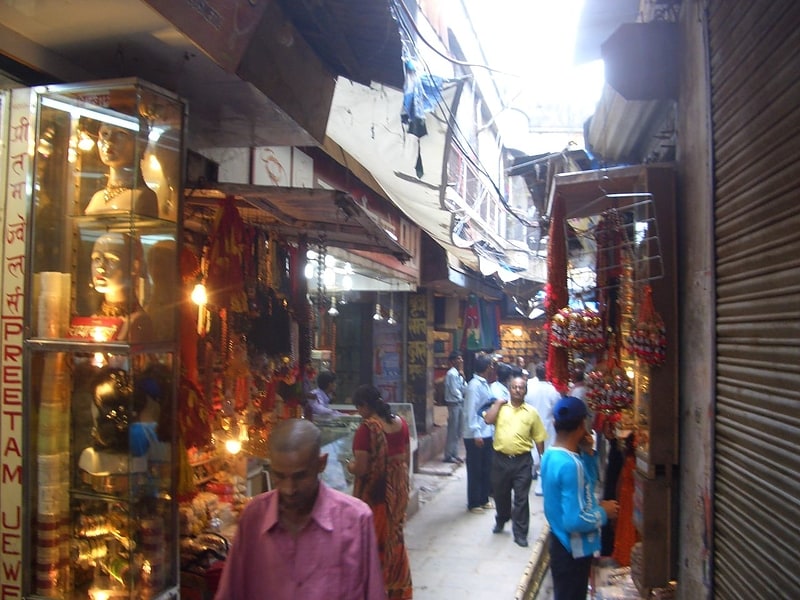
Also known as: काशी विश्वनाथ मन्दिर
Hindu temple in India. The Kashi Vishwanath Temple is a famous Hindu temple dedicated to Lord Shiva. It is located in Vishwanath Gali of Varanasi, Uttar Pradesh in India. The temple stands on the western bank of the holy river Ganga, and is one of the twelve Jyotirlingas, the holiest of Shiva temples. The main deity is known by the names Shri Vishwanath and Vishweshwara literally meaning Lord of the Universe. Varanasi was called Kashi in ancient times, and hence the temple is popularly called Kashi Vishwanath Temple.
The temple is considered a central part of worship in the Shaiva philosophy by Hindu scriptures. It had been demolished by many Muslim rulers many times, most recently by Aurangzeb, the sixth Mughal emperor who constructed the Gyanvapi Mosque on its site. The current structure was built on an adjacent site by the Maratha ruler, Ahilya Bai Holkar of Indore in the year 1780.
Since 1983, the temple has been managed by the government of Uttar Pradesh.[2]
Durga Temple
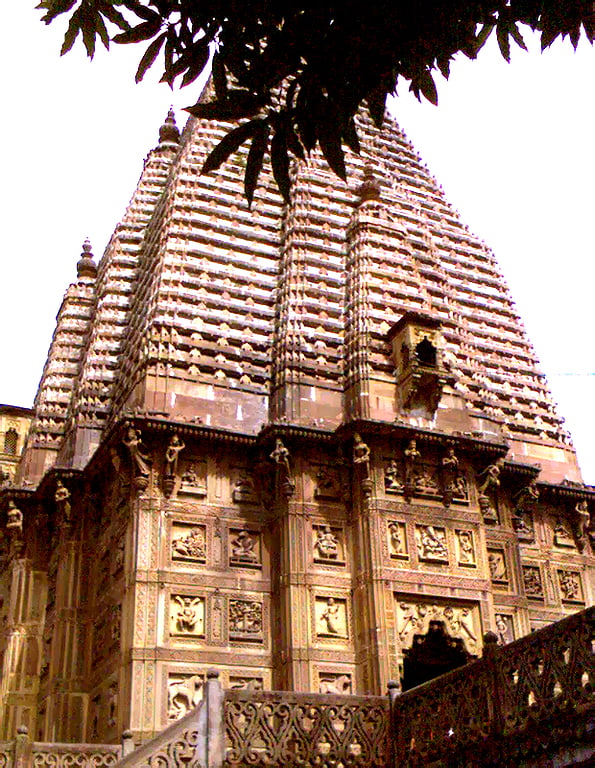
The Durga Mandir is situated in Ramnagar of Banaras. It is believed that it was built 500 years ago which is under control of royal family of Banaras State currently. This temple is devoted to Hindu deity Durga. The temple has a large stone built pond with it. The Durga Mandir boasts of its fine stone works, which is a fabulous example of north Indian stone work arts.
There is another Durga temple, within the Varanasi city, built in the 18th century overlooking a pond known as Durga Kund.[3]
Address: Durga Mandir Rd, 221008 Nathupur
New Vishwanath Temple
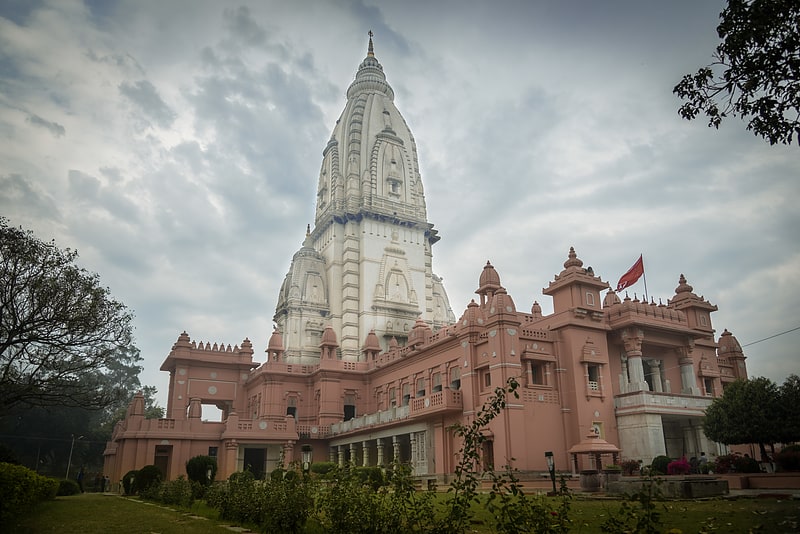
Also known as: श्री विश्वनाथ मन्दिर
Hindu temple in Varanasi, India. Shri Vishwanath Mandir also known as Vishwanath Mandir, Vishwanath Temple, New Vishwanath Temple and Birla Temple is one of the most famous temples and biggest tourist attractions in the Hindu holy city of Varanasi. The temple is situated in Banaras Hindu University and is dedicated to the Lord Shiva. Shri Vishwanath Mandir has the tallest temple tower in the world with the Shikhara's height being around 250 feet. The temple is colloquially called VT, an acronym of Vishwanath Temple.[4]
Durga Mandir

Also known as: दुर्गा मन्दिर, दुर्गाकुण्ड
Hindu temple in Varanasi, India. Durga Mandir, also known as Durga Kund Mandir and Durga Temple, is one of the most famous temples in the holy city of Varanasi. This temple has great religious importance in Hinduism and is dedicated to the Maa Durga. Durga Mandir was constructed in 18th century by Rani Bhabani of Natore.[5]
Address: 27, Durgakund Rd, 221005 Varanasi
Sarnath Museum
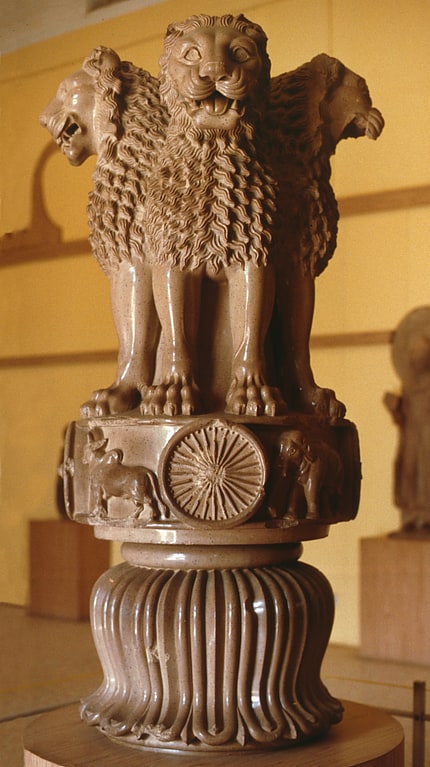
Also known as: सारनाथ संग्रहालय
Museum in Varanasi, India. Sarnath Museum is the oldest site museum of Archaeological Survey of India. It houses the findings and excavations at the archaeological site of Sarnath, by the Archaeological Survey of India. Sarnath is located near Varanasi, in the state of Uttar Pradesh. The museum has 6,832 sculptures and artefacts.[6]
Address: Dharmapala Rd, Varanasi
Chaukhandi Stupa
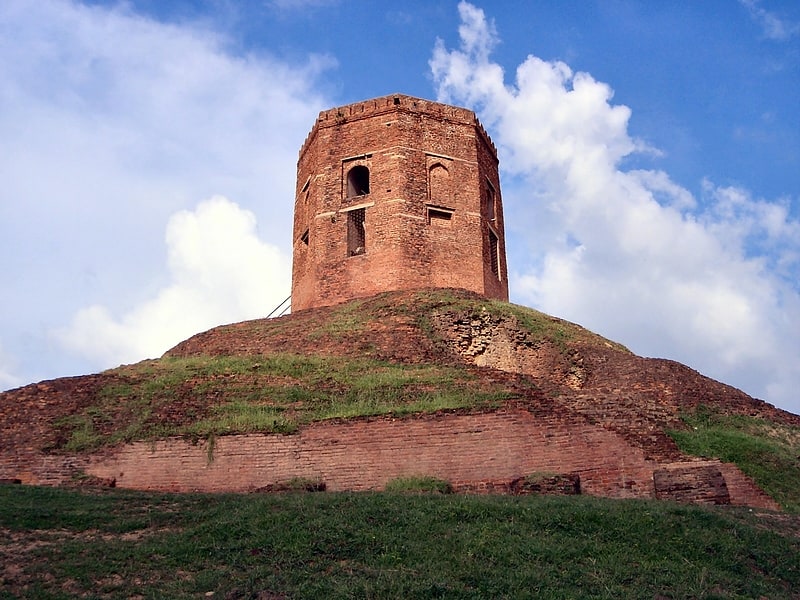
Also known as: चौखंडी स्तूप
Large historical Buddhist monument. Chaukhandi Stupa is a Buddhist stupa in Sarnath located 8 kilometres from Cantt Railway Station in Varanasi, Uttar Pradesh, India. Stupas have evolved from burial mounds and serve as a shrine for a relic of the Buddha. The site was declared to be a monument of national importance by the Archaeological Survey of India in June 2019.[7]
Address: Rishipattan Road, 221007 Varanasi
Gyanvapi Mosque
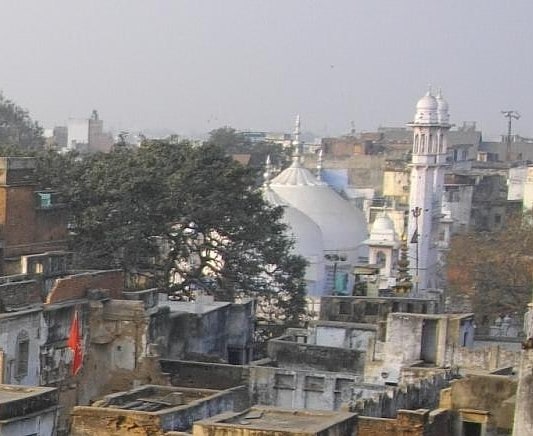
Mosque in Varanasi, India. The Gyanvapi Mosque is located in Varanasi, Uttar Pradesh, India. It was constructed on the site of an older temple of Vishweshwar, which had been demolished by the Mughal Emperor Aurangzeb in 1669.
The Gyanvapi Mosque is a Jama Masjid located in the heart of the Varanasi city, north of Dashashwamedh Ghat, near Lalita Ghat along the river Ganga. It is administered by Anjuman Inthazamiya Masjid (AIM).[8]
Address: 31-24, Gyanvapi Main Road, 221001 Gyanvapi
Jantar Mantar
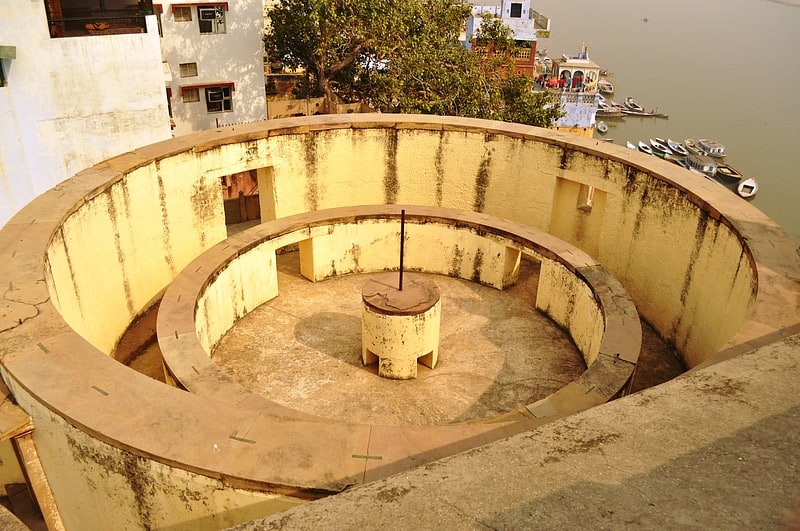
Also known as: जंतर मंतर, वाराणसी
Heritage museum in Varanasi, India. Jantar Mantar is an observatory built in Varanasi in the year 1737 by Maharaja Jai Singh II of kingdom of Amber. The observatory is one of the five built by Maharaja Jai Singh II.[9]
Ravidas Ghat
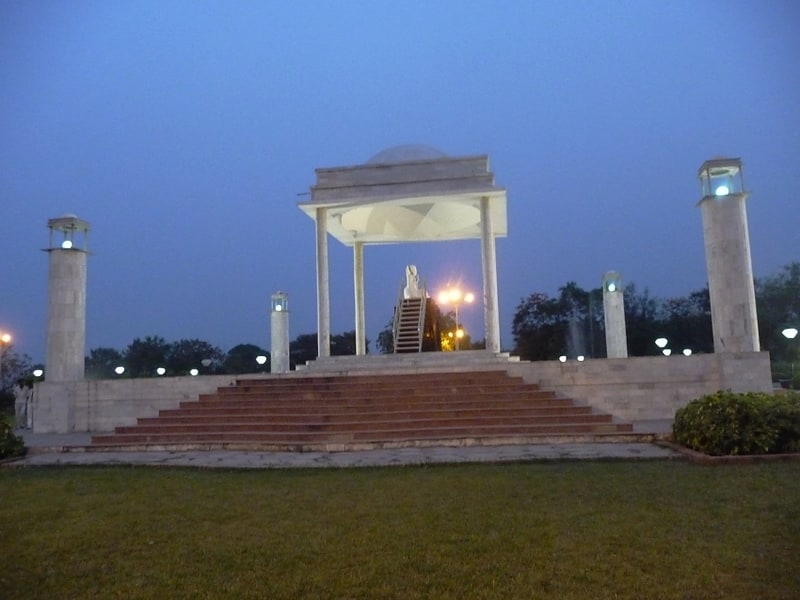
Sant Ravidas Ghat is the southernmost and largest ghat in Varanasi. To most visitors to Varanasi, it is known for being an important religious place Ravidasis with a 25 acres park known as Sant Ravidas Smarak Park.[10]
Address: Nagwa Lanka, Varanasi
Tulsi Manas Mandir

Also known as: तुलसी मानस मन्दिर
Hindu temple in Varanasi, India. Tulsi Manas Mandir is one of the most famous temples in the holy city of Varanasi. This temple has great historical and cultural importance in Hinduism since the ancient Hindu epic Ramcharitmanas was originally written at this place by Hindu poet-saint, reformer and philosopher Goswami Tulsidas in the 16th century.[11]
Address: Durgakund Rd, 221005 Varanasi
Nepali Mandir
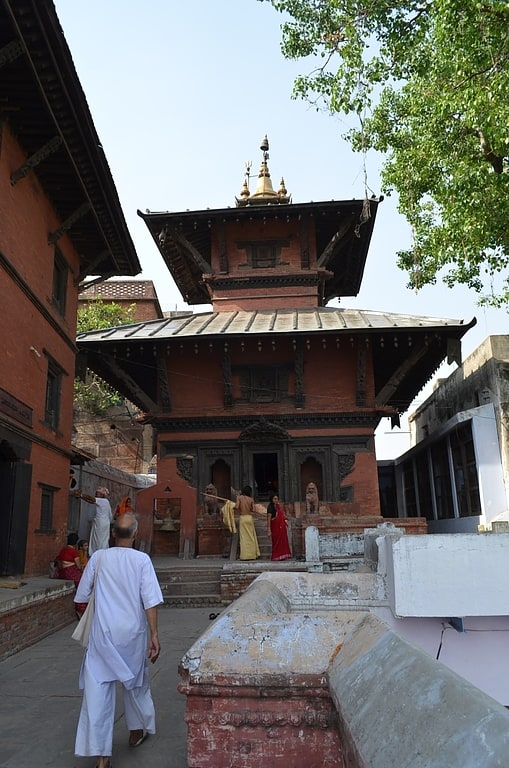
Temple in India. Shri Samrajeswar Pashupatinath Mahadev Mandir, also known as the Nepali Mandir, Kanthwala Mandir and Mini Khajuraho, is one of the oldest and most famous temples in the holy city of Varanasi. This temple has great religious importance in Hinduism and is dedicated to the Lord Shiva. Constructed in the 19th century A.D by the King of Nepal, the temple is made of terracotta, stone and wood and is replica of the Pashupatinath Temple in Kathmandu.[12]
Address: Lalita Ghat, Varanasi
Assi Ghat

Also known as: अस्सी घाट
Assi Ghat is the southernmost ghat in Varanasi. To most visitors to Varanasi, it is known for being a place where long-term foreign students, researchers, and tourists live.[13]
Tulsi Ghat
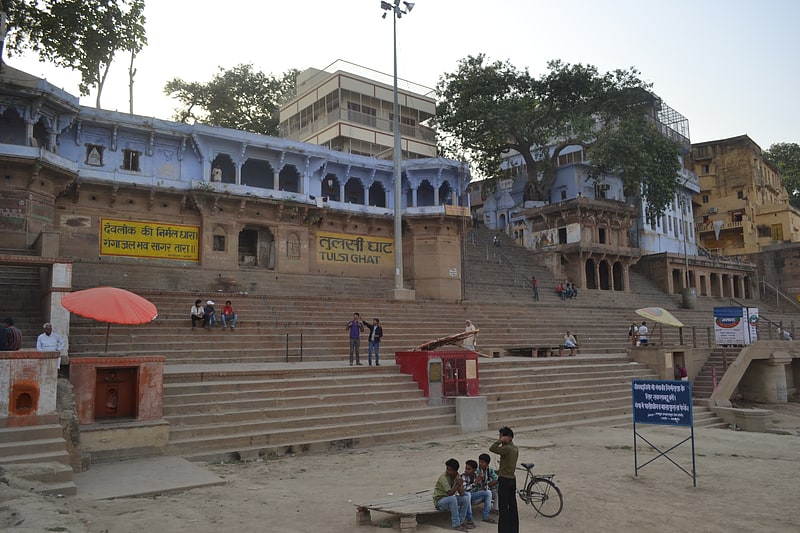
Also known as: तुलसी घाट
Hindu temple in Varanasi, India. Tulsi Ghat is one of the ghats in Varanasi. It is named after poet Tulsidas who lived there while he wrote the Ramcharitmanas. Earlier, Tulsi Ghat was known as Lolark Ghat. It was in the year 1941 that Tulsi Ghat was made pucca by industrialist, Baldeo Das Birla.[14]
Address: Assi Rd, 221010 Varanasi
Vishalakshi Temple

The Vishalakshi Temple or Vishalakshi Gauri Temple is a Hindu temple dedicated to the goddess Vishalakshi, at Mir Ghat on the banks of the Ganges at Varanasi in Uttar Pradesh, India. It is generally regarded as a Shakti Pitha, the most sacred temples dedicated to the Hindu Divine Mother.
The earrings of the goddess Sati are said to have fallen on this holy spot of Varanasi. The temple is situated by the famous cremation grounds of Manikarnika. Vishalakshi Temple is known for its temple festival on Kajali Tij, held on the third day during waning fortnight in the Hindu month of Bhadrapada (August).[15]
Sarnath Jain Tirth
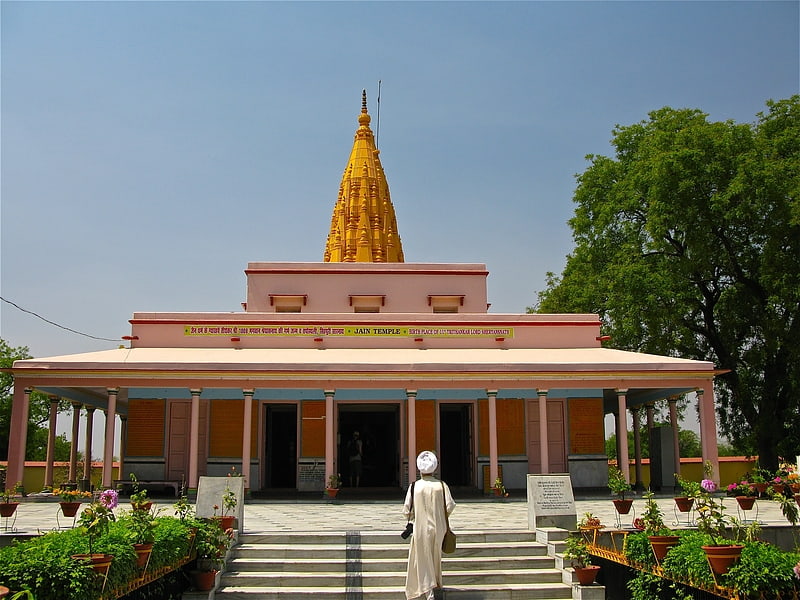
Sarnath Jain Tirth or Shri Singhpuri Jain Tirth is a Jain temple in Singhpuri village near Sarnath. The temple is situated near Dhamek Stupa.[16]
Bharat Mata Mandir

Also known as: भारत माता मन्दिर
Hindu temple in Varanasi, India. Bharat Mata Mandir is located on the Mahatma Gandhi Kashi Vidyapith campus in Varanasi,Uttar Pradesh, India. Instead of traditional statues of gods and goddesses, this temple has a huge map of undivided India carved in marble. This temple is dedicated to Bharat Mata and claims to be the only one of its kind in the world.[17]
Man Singh Astronomical Observatory
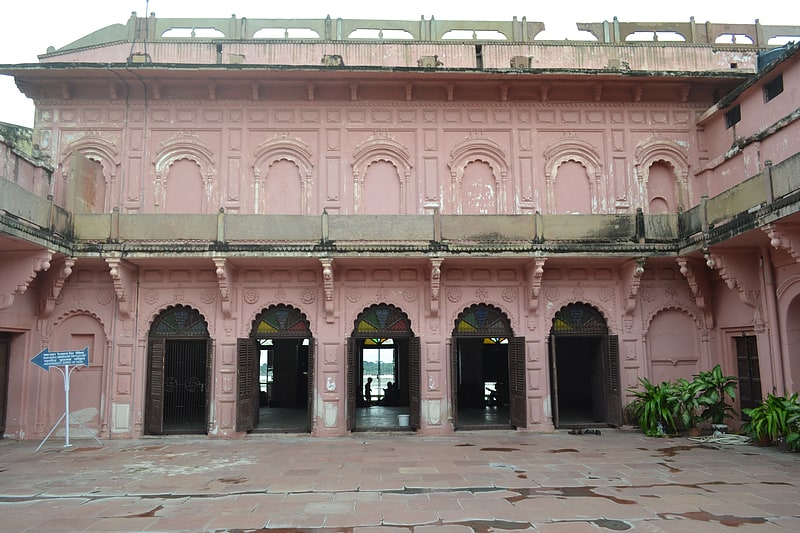
Museum
Malviya Bridge
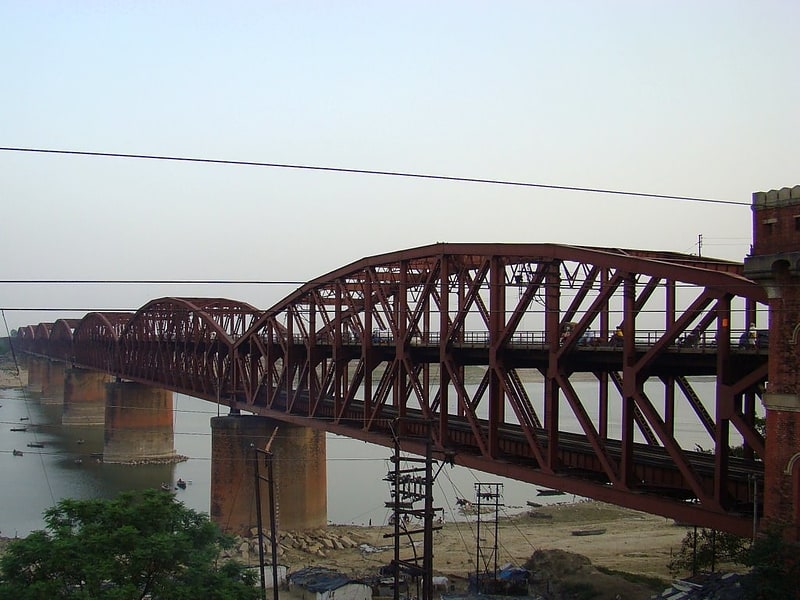
Bridge in India. Malviya Bridge, inaugurated in 1887, is a double decker bridge over the Ganges at Varanasi. It carries rail track on lower deck and road on the upper deck. It is one of the major bridges on the Ganges and carries the Grand Trunk Road across the river.
It has 7 spans of 350 ft and 9 spans of 110 ft and it was the first bridge of its type constructed in the Indian sub-continent by the engineers of Oudh and Rohilkhand Railway (O&R Railway). The engineer in charge of construction of the Dufferin Bridge was Frederick Thomas Granville Walton, who went on to become the Engineer in Chief of the Oudh and Rohilkhand Railway company. The bridge was renamed as the Malviya Bridge in 1948 after Madan Mohan Malaviya. As the bridge is near Rajghat, it is also locally known as Rajghat bridge. Malviya Bridge is between Kashi, Varanasi Junction and Pandit Deen Dayal Upadhyaya Junction (Mughalsarai Junction) stations.[18]
Sarnath

Also known as: सारनाथ
Village in India. Sarnath is a place located 10 kilometres north-east of Varanasi near the confluence of the Ganges and the Varuna rivers in Uttar Pradesh, India. The Deer Park in Sarnath is where Gautama Buddha first taught the Dharma, and where the Buddhist Sangha came into existence through the enlightenment of Kondanna.
Singhpur, a village approximately one kilometre away from the site, was the birthplace of Shreyansanath, the Eleventh Tirthankara of Jainism. A temple dedicated to him is an important pilgrimage site.
Also referred to as Isipatana, this city is mentioned by the Buddha as one of the four places of pilgrimage his devout followers should visit. It was also the site of the Buddha's Dhammacakkappavattana Sutta, which was his first sermon after attaining enlightenment, in which he explained the four noble truths and the teachings associated with them.[19]